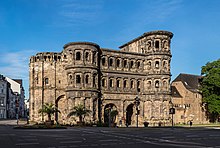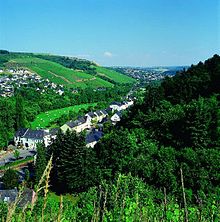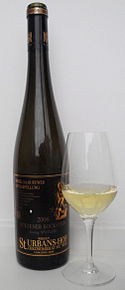Mosel (wine region)

Mosel (German: [ˈmoːzl̩] ⓘ) is one of 13 German wine regions (Weinbaugebiete) for quality wines (Qualitätswein, formerly QbA and Prädikatswein), and takes its name from the Mosel River (French: Moselle; Luxembourgish: Musel). Before 1 August 2007 the region was called Mosel-Saar-Ruwer, but changed to a name that was considered more consumer-friendly.[1][2] The wine region is Germany's third largest in terms of production but some consider it the leading region in terms of international prestige.[3]
The region covers the valleys of the rivers Mosel,
In the past two decades red wine production, especially from the Spätburgunder (
History

It is believed that
The Mosel wine of the Roman period was described as light bodied and "austere". It was said to be an easier drinking wine than that of other Roman areas. In the winter time, the wine was heated in a kettle and drunk like a

In the
Towards the end of the 17th century, the Kunda began to be identified more with wine made from the Riesling grape. The
The 19th century saw an unprecedented era of prosperity for the Mosel wine industry under the rule of Prussia starting with the historic vintage of 1819. For the rest of the 1820s, there was a succession of outstanding weather and sterling wines produced. To promote the region's wine, the Prussian government lowered the tariffs for the import of Mosel wines to other regions of the Prussian kingdom. The development of the Zollverein customs union even further benefited the Mosel by reducing the customs on their wines traveling to other regions of the German Confederation. A string of bad weather vintages in the late 1830s and early 1840s would dampen the extent of prosperity that the Mosel would see.[14]
By the 1850s, wine-makers in the Mosel had discovered the benefits of
Climate and geography

The Mosel wine region has northernly
The Mosel river dominates the geography of the region which is typically divided into three main sections. The Upper Mosel is the southernmost section located closest to the river's origins along the
Viticulture
The steep river bank slopes that are scattered around the Mosel region are considered some of the most labor-intensive vineyards in the world.

The Riesling grape, grown on 59.7% of the region's cultivated vineyard surface in 2008,[17] is widely considered the most prestigious and highest quality wine grape of the Mosel but it cannot be planted on every vineyard site due to difficulties the grape has in ripening in particularly cool climates. Factors such as altitude, aspect and sunlight exposure can have a pronounced effect not only one the resulting quality of the wine but also whether the Riesling grape will even ripen at all. A positive characteristic of the Riesling grape is that despite less than perfect ripeness it can still create a wine of finesse and elegance that would escape most other grape varieties.[5]
In place of Riesling, the easier cultivated Müller-Thurgau grape (14.7%) and other Riesling crossings like Kerner (4.6%) were planted in large quantities on the sites that were not suitable for Riesling, and which in many cases had been previously used for other agricultural purposes. A negative consequence of these large-scale plantings is that the wine produced from these sites are typically of a lower quality than Riesling wines which in turn has a depressing economic effect on the prices of all Mosel wines. While consumers have benefited with top quality Riesling wines being underpriced in comparison with some of the world's other great wines from places like Bordeaux, Burgundy and California, the economic hardship created by the prices has caused some of the smaller Mosel vineyards to go out of business.[3]
In 2008, the Mosel vineyards covered 9,034 hectares (22,320 acres), making it the fifth-largest of Germany's 13 wine regions.[17] White grape varieties cover 91 percent of the region's total vineyard surface. The trend in total vineyard area has until recently been slightly negative over a longer period of time, down from 12,760 hectares (31,500 acres) in 1988 to 9,533 hectares (23,560 acres) in 2003[18] and to 8,975 hectares (22,180 acres) in 2006.[19] It is primarily lesser sites previously planted with "low quality" varieties that have been abandoned in this process; during the 20-year period from 1988 to 2008, plantings of Müller-Thurgau decreased by 55% and those of Elbling by 49%. However, in 2007 and 2008, the negative trend in total plantations has been broken, and the Mosel vineyard surface has seen a small increase of 59 hectares (150 acres) in two years.
The projected
Wine region

Within the Mosel region, there are the following six districts (Bereiche) and 19 collective vineyard designations (Großlagen), plus 524 single vineyard (Einzellagen) designations. Four of the six districts are situated on the river Mosel, and one each on rivers Saar and Ruwer.

- District Burg Cochem / more commonly known as Untermosel or Terrassenmosel
The Cochem district is home to some of the steepest vineyards in the Mosel planted on soil composed of blue devonian slate, red slate and quartzite.[12] Many of the vineyards of the lower Mosel are terraced, which has led many producers to adopt the name Terrassenmosel, which sounds nicer than Untermosel in German. This district produces a higher proportion of dry wines than the rest of the region. A well known vineyard from this area is the Juffermauer located near Treis-Karden, whose name means "Virgin-Wall" in the local Franconian dialect/language.[20]
- District Bernkastel / more commonly known as Mittelmosel
This is the central district of the region. One of the most notable vineyards in this area is known as Doctorberg, and its wines as Bernkasteler Doctor. An
Other notable vineyards of the Mittelmosel include the

- District Ruwertal/ more commonly known as Ruwer (its formal name is due to the fact that Ruwer also is a suburb of Trier. The Ruwer is an estuary that flows into the Mosel; "Tal" is German for valley.)
Located to the southeast of Trier, this region includes the vineyards around Waldrach and Kasel. The region is home to many vineyards in Alleinbesitz (monopole). At Mertesdorf, there is a subterranean Roman aqueduct that connects the Grünhaus vineyard with the city of Trier. The quality of Ruwer wine is particularly dependent on the quality of the vintage with cool vintages marked by sharply acidic wines that quickly fade and warmer vintage producing some of the most delicate and perfumed expressions of German wines.[22]

- District Saar
Like the Ruwer region, wine from the Saar district (along the lower course of the
- District Obermosel
This wine district is composed of a thin strip of land along the Luxembourg border. The region starts just north of
- District Moseltor
The Moseltor area is the most southern area of the Mosel region, and is located together with the Obermosel along the Luxembourg border. The Elbling grape is the most commonly planted here producing a thin, rustic wine with high acidity.
Wines

The wines of the Upper Mosel, especially along the Saar and Ruwer tributaries, are characterized by their low
Plantings of
Grape varieties
The most cultivated grape varieties, by area in 2008, were:[24]
|
|
Associations

There are two major wine growers' associations in the Mosel region, the Großer Ring, which is a regional section of the
References
- ^ The wine-growing region Mosel-Saar-Ruwer had been renamed Mosel on 1 August 2007. [1].
- ^ Winetourism, May 5, 2022: Mosel-Saar-Ruwer shortens name to Mosel.
- ^ ISBN 0-7892-0883-0.
- ^ Der Bremmer Calmont.
- ^ ISBN 1-56305-434-5.
- ISBN 978-3-86244-686-5, p. 88.
- ISBN 9780520260672, pp. 43-45.
- ^ Pigott, Stuart et al., Wein Spricht Deutsch, Frankfurt: Scherz (part of S. Fischer Verlag), 2007, pp. 419, 442, passim.
- ISBN 0-671-68702-6.
- ^ ISBN 0-671-68702-6.
- ^ http://www.graf-von-katzenelnbogen.de/ The Mosel, the Counts of Katzenelnbogen and the First Riesling of the World.
- ^ ISBN 0-19-860990-6.
- ISBN 0-671-68702-6.
- ^ ISBN 0-671-68702-6.
- ^ ISBN 1-74048-050-3.
- ^ "J. Robinson, Mosel wine region".
- ^ a b German Wine Institute: German wine statistics 2009/2010 Archived 2011-07-26 at the Wayback Machine
- ^ German Wine Institute: German Wine Statistics 2004–2005 Archived 2009-09-20 at the Wayback Machine.
- ^ German Wine Institute: German Wine Statistics 2006–2006 Archived 2008-09-20 at the Wayback Machine.
- ISBN 1-56305-434-5.
- ISBN 1-56305-434-5.
- ^ ISBN 1-84000-332-4.
- ^ Wein-Plus Glossar: Mosel, accessed on January 22, 2013.
- Statistisches Bundesamt. 2008. Archived from the originalon 2011-08-12.
- ISBN 0-7566-1324-8.
External links
- Mosel-Saar-Ruwer Link no longer active.
- Mosel-Saar-Ruwer
- Mosel Wine Production Detail Archived 2008-12-24 at the Wayback Machine
